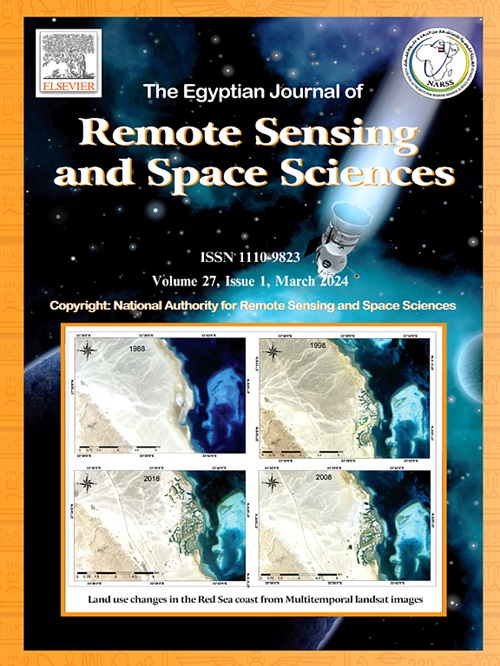利用机器学习算法评估影响滑坡的因素(案例研究:伊朗Karun-3大坝集水区)
IF 4.1
3区 地球科学
Q2 ENVIRONMENTAL SCIENCES
Egyptian Journal of Remote Sensing and Space Sciences
Pub Date : 2025-07-31
DOI:10.1016/j.ejrs.2025.07.005
引用次数: 0
摘要
山体滑坡是全球范围内与环境影响、人员和经济损失相关的现象之一。对管理人员和规划人员来说,调查诸如滑坡之类的环境问题和编制灾害地图是必不可少的。本研究利用随机森林(RF)、增强回归树(BRT)、广义聚合模型(GAM)、支持向量模型(SVM)、分类与回归树(CART)和广义线性模型(GLM)等六种机器学习算法,对伊朗胡齐斯坦省Karun-3大坝集水区的滑坡进行了研究和建模。确定了13个独立参数作为主要参数。然后,使用284个老滑坡来检验它们的相关性和影响,并使用效率、灵敏度和准确性指标验证机器学习模型。验证结果表明,虽然所使用的所有模型都具有足够的准确性,但RF模型(AUC = 0.982, Efficiency = 0.943)的准确性高于其他5种模型。不同因素对不同模型滑坡生成的影响也不尽相同。总的来说,上述参数的显著性在0.043 ~ 0.160之间。使用非参数检验比较不同模型的结果显示所使用的模型之间有更多的相似性。总的来说,各种模型的结果表明,在陡峭的河岸、湖泊、水坝和道路附近,特别是在泥沼等岩性较软的土地上,发生山体滑坡的风险通常较高。这一事实同时向我们表明了人为因素和自然因素的影响。本文章由计算机程序翻译,如有差异,请以英文原文为准。
Evaluating the factors affecting landslides using machine learning algorithms (case study: the catchment area of Karun-3 Dam, Iran)
Landslides are among the phenomena associated with environmental impacts and human and financial losses worldwide. Investigating environmental issues such as landslides and preparing hazard maps are essential for managers and planners. This study examines and models landslides in the catchment area of Karun-3 Dam located in Khuzestan province, Iran, using six machine learning algorithms, including Random Forest (RF), Boosted Regression Tree (BRT), Generalized Aggregate Model (GAM), Support Vector Model (SVM), Classification and Regression Tree (CART), and Generalized Linear Model (GLM). Thirteen independent parameters were identified as the main parameters. Then, their correlation and effects were examined using 284 old landslides, and machine learning models were validated using efficiency, sensitivity, and accuracy indicators. The validation results showed that although all the models used have sufficient accuracy, the RF model (AUC = 0.982, Efficiency = 0.943) has more accuracy than the other five models. Also, the impact of different factors on landslide generation in various models is not the same. In general, the significance of the mentioned parameters is in the range of 0.043 and 0.160. Comparing the results of different models using a non-parametric test shows more similarities between the models used. In general, the results of various models show that the risk of landslides is generally higher on the steep banks of rivers, in the vicinity of lakes, dams, and roads, and especially in lands with soft lithology such as marl. This fact shows us the influence of anthropogenic factors and natural factors simultaneously.
求助全文
通过发布文献求助,成功后即可免费获取论文全文。
去求助
来源期刊
CiteScore
8.10
自引率
0.00%
发文量
85
审稿时长
48 weeks
期刊介绍:
The Egyptian Journal of Remote Sensing and Space Sciences (EJRS) encompasses a comprehensive range of topics within Remote Sensing, Geographic Information Systems (GIS), planetary geology, and space technology development, including theories, applications, and modeling. EJRS aims to disseminate high-quality, peer-reviewed research focusing on the advancement of remote sensing and GIS technologies and their practical applications for effective planning, sustainable development, and environmental resource conservation. The journal particularly welcomes innovative papers with broad scientific appeal.

 求助内容:
求助内容: 应助结果提醒方式:
应助结果提醒方式:


